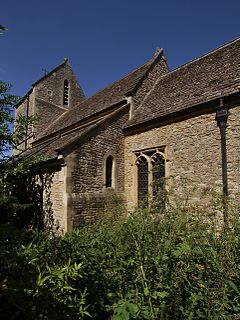Arthur Mee - The King's England, Oxfordshire.
Caversfield – The Silent Bell.
 Here we fount a thrilling thing to see, which should make the church a place of pilgrimage for the happy fellowship of ringers who fill the air with their peals, for what we can see and touch is the oldest bell surviving in this country.
Here we fount a thrilling thing to see, which should make the church a place of pilgrimage for the happy fellowship of ringers who fill the air with their peals, for what we can see and touch is the oldest bell surviving in this country.
Saxons lie here, for this is the tower which crowns the little Norman church; it has a saddleback roof and deeply splayed windows less than a foot high. The north porch has a fine Norman doorway, with rich chevrons and shafts and scalloped capitals, and in the nave are Norman arches on noble pillars carved with heads and foliage. There is a rare wealth of dainty lancet windows.
In the chancel, with the slender 13th century arch on clustered shafts, is the 15th century altar tomb of John Langston, richly panelled and traceried. He owned the manor here, and there are brasses to two other John Langstons, though one John has disappeared. John of 1435 is in a rich cloak, and here is the family of the missing John of two generations later. It has portraits of Amice Langton with her 12 sons and 10 daughters, the sons in flowing robes, the daughters with long hair, the mother in a flowing gown with a girdle.
The great treasure of the church, its famous bell, rests with its wheel on a frame under the tower. It has rung its last peal. Long and narrow, it is inscribed in primitive Saxon letters, “In honour of God and St. Laurence, Hugh Gargatt and Sibillia his wife had these bells erected.” Their names have indeed rung down the ages, for the bell is early 13th century. This is the patriarch of all our inscribed bells, the earliest that comes down to us with its age attested. For seven centuries it hung in this Saxon tower, the treble of its peal, clanging warnings of fire and war, summoning to prayer or to arms, new birth, acclaiming kings and coronations, and victories won by land and sea: Crecy, Poitiers, Agincourt, Flodden, Bosworth Field, Blenheim, Trafalgar and Waterloo. It rang for Norman priests who spoke no English, and for serfs listening to the service in Latin. It was as old to Shakespeare as Shakespeare is to us. It had been ringing for nearly 400 years before its voice was added to the chorus announcing that the Armada was defeated. But young upstart bells have come, with whose mellow tones this veteran could not hamonise, and he has descended from his ancient belfry, off duty at last, silent after seven centuries of ringing, a silver singer to be heard no more.
W Hobart Bird - Old Oxfordshire Churches
The small church of St. Lawrence has been to a great extent rebuilt so that its interest is diminished. One writer on the church definitely states that the tower is Saxon, but the present writer has satisfied himself and others that the existing tower is not Saxon, and there is no evidence to that effect. The two archaic-looking lights inserted in the lower stage are no proof that the masonry of the fabric is Saxon. It is obviously a rebuilt tower of much later date; in fact, the masonry and the quoins and the openings are comparatively modern. The good Norman south doorway has evidently been reset. The jamb-shafts and arches are of two orders, the outer with sculptured capitals, chamfered imposts and roll mould arch and another order with a roll mould within a chevron; the bold label has “mask” stops. All of the lancet lights and tracery of the windows is modern, in fact practically the whole fabric has been rebuilt. The peculiar masonry of the quoins shows it, also the stonework around the windows. The quire has two tall Early English lights in deep splays at the East, with a small lancet North, also an ambury and a tomb recess with an altar-tomb having richly panelled sides and a Purbeck marble top with an inscription brass above it t John Langton, 1487. There are two 27-inch brasses to a man and a woman, and two others with their 22 children, also three heraldic brasses.
The rebuilt quire arch is Early English with clustered responds and an arch of two chamfered orders. The rebuilt arcades are very interesting, as showing Transitional work in the pillars and capitals but fully developed Early English in the moulded arches, with dog-tooth ornament and “mask” stops. The fine and interesting Norman font has intersecting arcaded ornament of somewhat rude work.